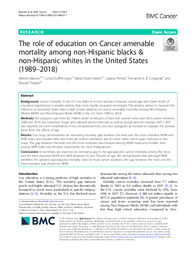Por favor, use este identificador para citar o enlazar este ítem:
https://hdl.handle.net/11000/30536Registro completo de metadatos
| Campo DC | Valor | Lengua/Idioma |
|---|---|---|
| dc.contributor.author | BARCELO, ALBERTO | - |
| dc.contributor.author | Duffett-Leger, Linda | - |
| dc.contributor.author | Pastor-Valero, Maria | - |
| dc.contributor.author | Pereira, Juliana | - |
| dc.contributor.author | Colugnati, Fernando | - |
| dc.contributor.author | Trapido, Edward | - |
| dc.contributor.other | Departamentos de la UMH::Salud Pública, Historia de la Ciencia y Ginecología | es_ES |
| dc.date.accessioned | 2024-01-17T18:00:46Z | - |
| dc.date.available | 2024-01-17T18:00:46Z | - |
| dc.date.created | 2021-09 | - |
| dc.identifier.citation | BMC Cancer Volume 21, article number 907, (2021) | es_ES |
| dc.identifier.issn | 1471-2407 | - |
| dc.identifier.uri | https://hdl.handle.net/11000/30536 | - |
| dc.description.abstract | Background: Cancer mortality in the U.S. has fallen in recent decades; however, individuals with lower levels of education experienced a smaller decline than more highly educated individuals. This analysis aimed to measure the influence of education lower than a high school diploma, on cancer amenable mortality among Non-Hispanic Whites (NHW) and Non-Hispanic Blacks (NHB) in the U.S. from 1989 to 2018. Methods: We analyzed data from 8.2 million death certificates of men and women who died from cancer between 1989 and 2018. We examined 5-year and calendar period intervals, as well as annual percent changes (APC). APC was adjusted for each combination of sex, educational level, and race categories (8 models) to separate the general trend from the effects of age. Results: Our study demonstrated an increasing mortality gap between the least and the most educated NHW and NHB males and females who died from all cancers combined and for most other cancer types included in this study. The gap between the least and the most educated was broader among NHW males and females than among NHB males and females, respectively, for most malignancies. Conclusions: In summary, we reported an increasing gap in the age-adjusted cancer mortality among the most and the least educated NHW and NHB between 25 and 74 years of age. We demonstrated that although NHB exhibited the greatest age-adjusted mortality rates for most cancer locations, the gap between the most and the least educated was shown for NHW. | es_ES |
| dc.format | application/pdf | es_ES |
| dc.format.extent | 13 | es_ES |
| dc.language.iso | eng | es_ES |
| dc.publisher | BMC [Commercial Publisher] | es_ES |
| dc.rights | info:eu-repo/semantics/openAccess | es_ES |
| dc.rights | Attribution-NonCommercial-NoDerivatives 4.0 Internacional | * |
| dc.rights.uri | http://creativecommons.org/licenses/by-nc-nd/4.0/ | * |
| dc.subject | cancer | es_ES |
| dc.subject | cancer mortality | es_ES |
| dc.subject | APC | es_ES |
| dc.subject.other | CDU::6 - Ciencias aplicadas::61 - Medicina | es_ES |
| dc.title | The role of education on Cancer amenable mortality among non-Hispanic blacks & non-Hispanic whites in the United States (1989–2018) | es_ES |
| dc.type | info:eu-repo/semantics/article | es_ES |
| dc.relation.publisherversion | https://doi.org/10.1186/s12885-021-08633-7 | es_ES |

Ver/Abrir:
3-BMC-2021 (1).pdf
1,79 MB
Adobe PDF
Compartir:
 La licencia se describe como: Atribución-NonComercial-NoDerivada 4.0 Internacional.
La licencia se describe como: Atribución-NonComercial-NoDerivada 4.0 Internacional.
.png)